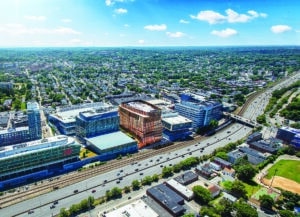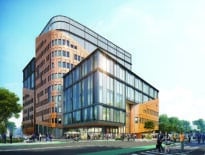
Experts say Greater Boston’s huge volumes of lab space under construction could give international biotechs without a local presence an opportunity to plant their flag. iStock illustration
It might not be the life science leasing boom times of recent years, but there are still opportunities to be captured in Greater Boston’s signature commercial real estate sector.
It’s simply a tenant market these days instead of landlords having the edge. While lab and life science vacancy rates hovering near 0 percent were a staple of the East Cambridge market for much of the past decade, spilling demand into nearby cities, industry demand has softened just as a pipeline promises to deliver approximately 16 million square feet of new projects, according to brokerage data.
Middlesex County, which includes Cambridge’s Kendall Square industry hotbed, has a 6.2 percent vacancy rate with 42.3 million square feet of inventory and an additional 9.5 million square feet under development, according to trade group MassBio’s 2023 Industry Snapshot.
Suffolk County, which includes Boston and the growing Seaport life science cluster, has a 3.7 percent vacancy rate with 4.4 million square feet of projects in development to add to the existing 16 million square feet of inventory.
Room to Grow
While the data offers cautionary guidance for the short term, industry experts say it’s still too early to ring the alarm bell on development prospects. The amount of wiggle room in inventory provides growth opportunities for companies that have yet to establish a beachhead in Greater Boston, and others still in growth mode.
“I understand the apprehension that the real estate community has and haven’t seen these vacancy rates in a long time,” said Ben Bradford, head of external affairs at MassBio. “But for the health of the life sciences ecosystem here in Massachusetts, these rates feel a whole lot healthier than the rates that we were seeing three or four years ago because it’s allowing companies to grow as needed.”
The dog-eat-dog leasing climate of not-so-long-ago was cutthroat due to the region’s negligible vacancy rate. It wasn’t unheard of for companies to take larger swaths of space than they needed, and squat on it because it wasn’t clear when available opportunities would again present.
“Companies that might not have been ready for 50,000 square feet took it because they didn’t know if they’d ever seen 25,000 square feet again,” Bradford said.

Biotechs have the most choices in nearly a decade with 4.4 million square feet of development projects including the 350,000-square-foot Forum at Boston Landing in Brighton, co-developed by Lendlease and Ivanhoé Cambridge. Image courtesy of SGA
Overseas Options May Fill New Niche
So, what kind of companies might ponder a Greater Boston expansion now that there’s space to be had? Experts aren’t giving specific tenant names, but they pointed to certain types of firms that aren’t here yet.
Pharmaceutical and life science firms based in Asia or Europe are potential growth drivers, as well as international firms that might have a presence elsewhere in the U.S. but not yet Massachusetts.
“There are opportunities for companies that are looking to come into Boston, for whatever reason, be it they want to be in the biggest cluster in the world and now is an opportunity to find space, or maybe they have a small footprint here and they’re looking to grow that,” said Elizabeth Berthelette, the head of northeast and national life science research at Newmark. “I do think there’s opportunity all around.”
Money talks, and the high cost of doing business in the region might have been keeping some of these companies away when space was so limited.
“My guess is over the last five years or so they didn’t even think about Massachusetts because certainly the cost of doing business here is high, and then if you’re going to get into a battle for lab space, it may not make sense to enter the Massachusetts market,” Bradford said. “But those battles aren’t necessarily going to be there because the space is now available. So, I think we could see some international companies explore Massachusetts for business development and innovation centers in a way that we haven’t in the last decade or so.”
That’s good news for tenants, but real estate developers and brokers probably aren’t wearing the same kind of rose-colored glasses.
There is a parade of major new projects under construction that have yet to announce their first tenant: BioMed Realty’s Seaport Science Center in a conversion of John Hancock Life Insurance’s former offices, and the first building at its Assembly Innovation Park in Somerville. On Sept. 14, Lendlease and Ivanhoé Cambridge held a topping-out ceremony for their $545 million Forum lab tower at Boston Landing in Brighton, which is marketing subdividable floor plates for smaller biotechs. Greystar is offering 465,000 square feet of lab space at 74 Middlesex Ave. in Somerville, which is scheduled for completion next spring. That’s roughly the same time that Boston-based King Street Properties is scheduled to complete its 465,000-square-foot Allston Labworks project on Western Avenue.
As developers try to maximize their appeal to potential tenants, they can’t rely on a reliable tool used to good effect in other asset classes. Life science is less reliant on amenities one-upmanship than the office sector, experts say.
Instead, it likely all boils down to an old-school real estate fundamental: Location, location, location.
“If there’s a new building in untested markets, that’s certainly something to keep an eye on,” Berthelette said, speaking in broad terms of tenant demands and not about any specific development. “Tenants will be able to choose where they want to go, and I think it’ll end up being more about location.”




 |
| 

